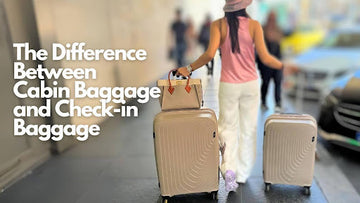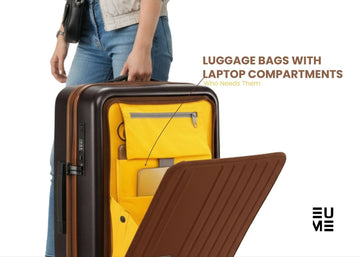Introduction
Traveling by air can be a breeze if you know the ins and outs of your baggage options. Understanding the difference between cabin baggage and check-in baggage is crucial for a smooth journey. Whether you're a seasoned traveler or a newbie, this guide will help you navigate the skies with ease.
What is Cabin and Check-in Baggage?
Cabin baggage, also known as carry-on luggage, is the bag you take with you into the airplane cabin. It is stored in the overhead compartment or under the seat in front of you. Check-in baggage, on the other hand, is handed over at the airline counter and stored in the plane's cargo hold.
To put it simply, cabin baggage is your travel companion, while check-in baggage is your travel buddy that you reunite with at your destination. Knowing the difference between these two can save you time, money, and a lot of hassle.
Size Matters: Dimensions and Weight Limits
Cabin Baggage Size and Weight
Cabin baggage typically has strict size and weight limits. Most airlines allow a maximum size of 55x35x25 cm (21.7x13.8x9.9 inches) and a weight limit of 7-10 kg (15-22 lbs). Always check your airline's specific guidelines to avoid surprises at the gate. If you're looking for a reliable option, consider investing in a quality cabin luggage that meets these requirements.
Check-in Baggage Size and Weight
Check-in baggage can be larger and heavier. The standard size limit is around 158 cm (62 inches) in total dimensions, and the weight limit is usually 23 kg (50 lbs). Some airlines offer higher allowances for premium ticket holders or charge extra for overweight bags. For those who travel frequently or need more space, a durable luggage set can be a worthwhile investment.
Packing Priorities: What Goes Where?
Essential Items for Cabin Baggage
Your cabin baggage should contain essential items like travel documents, medications, electronics, and valuables. Think of it as your in-flight survival kit. Items like laptops, cameras, and a change of clothes are also good to keep close. Additionally, consider packing a small toiletry bag with essentials like toothpaste, a toothbrush, and face wipes to freshen up during the flight.
When traveling with more gear, a luggage set of 2 can make packing more organized for those needing both a cabin bag and checked baggage.
Items Best Suited for Check-in Baggage
Check-in baggage is ideal for bulkier items like clothing, shoes, and toiletries. Since these bags are stored in the cargo hold, you won't have access to them during the flight, so pack accordingly. Avoid putting valuable or fragile items in check-in baggage to prevent damage or loss. If you're traveling with gifts or souvenirs, it's best to wrap them securely and place them in your check-in luggage.
A luggage set of 3 provides ample space for long trips or group travel, allowing for efficient packing of both essentials and extra items.
Airline Policies and Variations
Airline policies can vary significantly, so it's essential to check the specific rules of the airline you're flying with. Some airlines allow an additional personal item like a handbag or laptop bag along with your cabin baggage, while others may have stricter rules. Always double-check to avoid any last-minute hassles.
For instance, budget airlines often have more restrictive policies compared to full-service carriers. Some airlines may even charge for cabin baggage if it exceeds their size or weight limits. On the other hand, premium airlines might offer more generous allowances, especially for business or first-class passengers.
Pros and Cons: Cabin Bag vs. Check-in Bag
Advantages of Cabin Baggage
- Quick Access: Keep essential items within reach.
- No Waiting: Skip the baggage claim and head straight out of the airport.
- Reduced Risk: Lower risk of lost or damaged items.
- Cost-Effective: Avoid extra fees for checked baggage on budget airlines.
Advantages of Check-in Baggage
- More Space: Ideal for longer trips requiring more clothing and items.
- Less Hassle: No need to lug heavy bags through the airport.
- Flexible Packing: Less stringent size and weight restrictions.
- Better for Families: Easier to manage when traveling with children or in a group.
Top Tips for Efficient Packing
Packing Hacks for Cabin Baggage
- Roll Your Clothes: Save space and reduce wrinkles.
- Use Packing Cubes: Organize your items for easy access.
- Limit Liquids: Follow the 100 ml rule for liquids and pack them in a transparent bag.
- Wear Bulky Items: Wear heavier clothing items like jackets and boots to save space in your bag.
- Multi-Use Items: Pack items that can serve multiple purposes, like a scarf that can double as a blanket.
Packing Tips for Check-in Baggage
- Distribute Weight: Evenly distribute weight to avoid overweight fees.
- Protect Fragile Items: Use clothing or bubble wrap for extra cushioning.
- Label Your Bag: Include your contact information in case your bag gets lost.
- Vacuum Bags: Use vacuum-sealed bags to compress bulky items like jackets and sweaters.
- Plan Outfits: Plan your outfits in advance to avoid overpacking and ensure you have everything you need.
Final Verdict
In conclusion, understanding the difference between cabin baggage and check-in baggage is essential for a smooth travel experience. By knowing what to pack and where to pack it, you can avoid unnecessary stress and enjoy your journey. Whether you're looking for a reliable cabin luggage or a complete luggage set, EUME has got you covered.
Ready to upgrade your travel gear? Visit EUME for top-quality luggage options that suit all your travel needs. From stylish cabin bags to durable luggage sets, we have everything you need to travel in style and comfort.
Cabin Baggage vs. Check-in Baggage: All Your Questions Answered
Q: What is the size limit for cabin baggage?
The typical size limit for cabin baggage is 55x35x25 cm (21.7x13.8x9.9 inches) with a weight limit of 7-10 kg (15-22 lbs).
Q: Can I carry liquids in my cabin baggage?
Yes, but each container must not exceed 100 ml, and all containers must fit in a 1-liter transparent bag.
Q: What items should I pack in my cabin baggage?
Pack essential items like travel documents, medications, electronics, and valuables in your cabin baggage.
Q: What is the weight limit for check-in baggage?
The standard weight limit for check-in baggage is usually 23 kg (50 lbs), but this can vary by airline.
Q: Can I check in a bag that is described as cabin baggage?
Yes, you can check in a bag described as cabin baggage, but ensure it is durable enough to handle the cargo hold conditions.






















